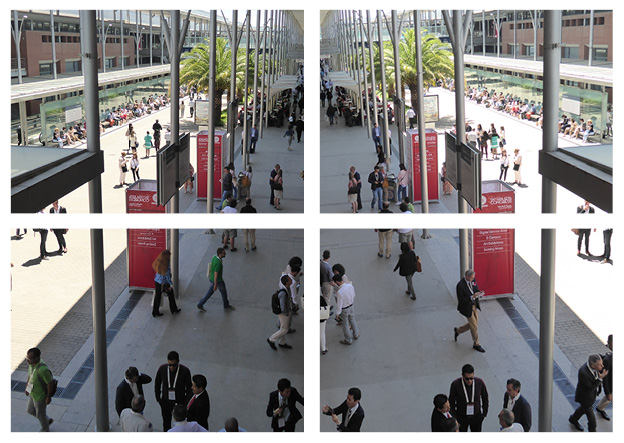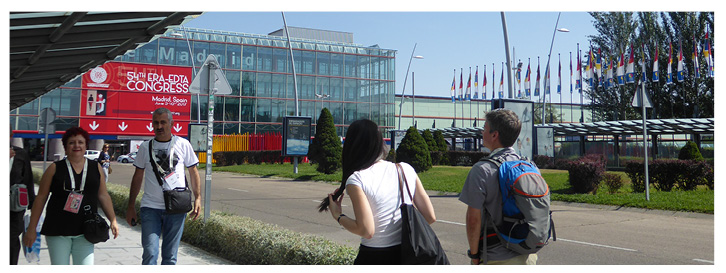The 54th European Renal Association – European Dialysis and Transplant Association (ERA-EDTA) Congress took place in the beautiful city of Madrid, and the Spanish capital was a truly fitting venue for this prestigious medical event. It is the place where the renowned Nobel Prize winning neuroscientist, Santiago Ramón y Cajal, made some of his most seminal findings, and, in keeping with Madrid being the highest capital city in Europe, as it is on a plateau 650 metres above sea level, participants were treated to some sky-high sessions during the 4-day event.
There were >300 expert speakers from >100 different countries who descended upon Madrid for the congress, which included 61 symposia, 4 plenary lectures, and 37 free communications sessions covering all aspects of the nephrological spectrum that kept the delegates engrossed in the proceedings. During an action-packed opening ceremony, ERA-EDTA President Prof Andrzej Więcek took some time to explain the enormous growth in popularity of the society and its congress: “The number of members of ERA-EDTA is continuously growing, and recently our number exceeded 7,400 members. With regards to the number of abstracts submitted to the congresses during the last 6 years, we received here in Madrid almost 2,500 abstracts, which is a quite similar number to the previous years, and the number of accepted abstracts is above 1,900, which is almost at the top of the list over the last 6 years.” He also discussed some of the most prevalent topics that the abstracts covered, including an exciting new category: ‘Patient Education, Research, and Training in Nephrology’.
A number of prestigious awards recognising significant contributions to the field were given out at the opening ceremony. Prof Dontscho Kerjaschki (Vienna, Austria) took the prize for ‘Outstanding Basic Science Contributions to Nephrology’, and Prof Giuseppe Remuzzi (Bergamo, Italy) was presented with the award for ‘Outstanding Clinical Contributions to Nephrology’. Prof Peter Stenvinkel (Stockholm, Sweden) was handed the prize for ‘Outstanding Educational Contributions to Nephrology, Prof Jonathan G. Fox (Glasgow, UK) was acknowledged for ‘Outstanding Contributions to ERA-EDTA’, and the Stanley Sheldon Award for Young Investigators went to Dr Albertien van Eerde (Utrecht, Netherlands). Additionally, an ERA-EDTA Honorary Membership was awarded to Dr François Berthoux (St. Etienne, France). Attendees at the ceremony were also treated to a fascinating lecture by Prof Juan Carlos Izpisua Belmonte entitled: ‘New approaches towards kidney regeneration’.
As expected, the medical science on offer was of the highest possible standard, with numerous sessions tackling some of the most prescient and challenging issues in the field. One session looked in depth at the topic of ageing in chronic kidney disease patients. These patients display significantly more discrepancies between chronological and biological age than those with most other diseases, and this is clearly a vital area for further research. Another looked at a particularly difficult challenge in Europe in the modern age: that of care for the elderly, with a focus on kidney care, including a discussion on the use of advanced care planning. There was also a fascinating session on the Dialysis Outcomes and Practice Patterns Study (DOPPS). This programme began in 1996 with the goal of understanding haemodialysis facility practices and informing people of the best practices in haemodialysis care and has grown hugely over the years, with 23 countries now participating. In this session, the important work of the programme and its recent research was explained to the audience.
We hope that you enjoy our review of this year’s ERA-EDTA Congress, which was an informative and exciting event for all nephrology professionals in attendance. In this section, we review a number of studies that were presented on areas such as pathology and treatment options for conditions including lupus nephritis, chronic kidney disease, and glomerulonephritis. Next year’s ERA-EDTA Congress takes place in Copenhagen, Denmark, and we hope to see you all there!

Voclosporin Improves Complete Remission Rates in Lupus Nephritis Patients
COMPLETE remission in patients with lupus nephritis was found to be much more likely after treatment with low-dose voclosporin, a calcineurin inhibitor, in addition to standard immunotherapy, compared with placebo. These results were from the AURA-LV trial and were reported on in an ERA-EDTA press release dated 4th June.
This double-blind Phase II trial enrolled 265 patients who had active lupus nephritis and randomised them to either placebo, high-dose voclosporin (39.5 mg twice-daily), or low-dose voclosporin (23.7 mg twice-daily). In addition, patients in all study arms were treated with 2 g per day of mycophenolate mofetil and rapidly tapering steroid doses. The trial’s primary outcome was the achievement of complete renal remission (defined as urine protein-creatinine ratio ≤0.5 mg/mmol and either an estimated glomerular filtration rate ≥60 mL/min/1.73 m2 or no decrease in the baseline estimated glomerular filtration rate of ≥20% in the presence of low-dose steroids), which was assessed at Week 24. An assessment of the efficacy of voclosporin compared with placebo was made at Week 48 and was the secondary outcome.
The trial found that, at Week 24, 32.6% of patients treated with low-dose voclosporin achieved complete renal remission (odds ratio [OR]: 2.03; p=0.045). The corresponding figure in the placebo group was 19.3%. At Week 48, complete renal remission was higher in both voclosporin arms compared with the placebo arm (low-dose OR: 3.21; p<0.001; high-dose OR: 2.10; p=0.026). Also, at Week 48, no significant differences in renal function were identified. Overall, there were 13 deaths, and most of these deaths took place during the first 2 months of the study. Ten patients died in the low-dose group, 2 in the high-dose group, and 1 in the control group. The trial investigators believed that none of the deaths were related to voclosporin.
Speaking about the AURA-LV trial, the lead investigator, Dr James Tumlin, Southeast Renal Research Institute, Chattanooga, Tennessee, USA said: “This study demonstrates that voclosporin has positive additive effects on lupus nephritis with a rapid reduction of oral steroids. These promising data are a basis for a Phase III study to validate the efficacy of low-dose voclosporin in lupus nephritis.”
Biomarkers for Premature Ageing in Patients with Chronic Kidney Disease
ARTERIAL expression of the cyclin-dependent kinase inhibitor 2A/B (CDKN2A/B), and its related protein p16INK4a, serves as a biomarker of premature vascular ageing in patients with chronic kidney disease (CKD), suggests a new study by researchers from the Karolinska Institute, Stockholm, Sweden, reported in an ERA-EDTA press release dated 5th June.
Patients with CKD exhibit a pronounced discrepancy between chronological age and biological age, more so than in all but a few other diseases, presenting an excellent opportunity to study premature vascular ageing. Furthermore, CKD patients present with a progeric vascular phenotype that is very difficult to model in animals. Several elements within the uraemic milieu are connected to premature ageing, including increased allostatic load (inflammation and oxidative stress); pro-ageing factors, such as hyperphosphataemia, angiotensin 2, and sodium; and defective anti-ageing protective mechanisms, such as vitamin D deficiency and nuclear lamina defects. Indeed, when CKD has advanced to end-stage renal disease, the risk of cardiovascular mortality is greatly increased, and occurs in much younger patients, because of vascular calcification and ageing.
Proteins coded by CDKN2A/B function as part of the mechanism to keep cells in a state of growth arrest. Therefore, because the expression of the gene increases as a function of increasing cellular stress and organismal ageing, and cellular senescence increases with age, CDKN2A/B appears to be an excellent biomarker for biological age. Now, by analysing arterial biopsies from 61 CKD patients undergoing living donor renal transplantation, researchers have observed that, in the uraemic milieu, increased expression of CDKN2A/p16INK4a is associated with vascular progeria, independent of chronological age. A previous study, conducted on mice, had identified p16INK4a as playing a role in the calcification and ageing of vascular smooth muscle cells, but this new study represents the first time such age-related findings were made in human arterial uraemic tissue.
“Thus, CDKN2A/p16INK4a is a biomarker of premature vessel ageing in CKD patients. Now we need to find out if it could also be a therapeutic target to address cellular senescence,” explained Prof Peter Stenvinkel, Karolinska Institute.

Decreasing Serum Phosphate Levels May Reduce Mortality
REDUCING serum phosphate levels could reduce relative mortality by 12%, according to the results of the COSMOS study, led by researchers from the Bone and Mineral Research Unit, Hospital Universitario Central de Asturias, Oviedo, Spain, and reported on in an ERA-EDTA press release dated 4th June. The proper functioning of the kidneys is integral to phosphate regulation, so patients with chronic kidney disease are particularly susceptible to the increased risk of cardiovascular complications associated with high phosphate concentrations.
The study observed 6,797 haemodialysis patients, randomly selected from 227 centres across Europe, and sought to identify the association between reductions in serum phosphate levels and the relative risk of mortality. Patients were observed for six periods of 6 months, and researchers found that reducing serum phosphate (-1.1 mg/dL) towards a target range of 3.6–5.2 mg/dL, from a mean of 6.5 mg/dL, was linked to a 12% reduction in the relative risk of mortality.
This study also identified the significance of the timing of blood sample withdrawal, finding that samples taken post-weekend displayed significantly higher phosphate levels (p>0.001) than those taken midweek. Crucially, this aspect of the analysis also indicated an association between serum phosphate levels, including the safest ranges, and the lowest risk of mortality; this is an important discovery that is likely to influence the guidelines for clinical management of hyperphosphataemia.
“For the first time, using a COSMOS analyses which mimics as much as possible what happens in randomised clinical trials, it was found that the reduction of serum phosphorus in dialysis patients may render the expected benefits, as it is associated to better survival. In addition, the analyses showed that the time of blood withdrawal (related to the extent of the intradialytic period) matters as influences not only serum phosphate but also its association with survival. This aspect should be considered in future guidelines for its important clinical implications,” explained Prof Jorge Cannata-Andia and Dr Jose Luis Fernández, Hospital Universitario Central de Asturias.
Targeted-Release Formulation Budesonide Reduces Proteinuria
A NEW target-release formulation (TRF)-budesonide may be the first specific therapy for immunoglobulin A (IgA) nephropathy. The formulation enables accurate delivery of budesonide to the intestine, where it selectively targets the mucosal immunity, upstream of disease manifestation, whilst restricting systemic glucocorticoid absorption. The findings of the NEFIGAN trial were reported in an ERA-EDTA press release dated 4th June 2017.
The NEFIGAN study was a randomised, double-blind, placebo-controlled Phase IIb trial investigating the addition of TRF-budesonide (16 mg/day or 8 mg/day) or placebo. Patients were randomised 1:1:1 and stratified by baseline urine protein creatinine ratio (UPCR). The trial’s purpose was to assess the safety and efficacy of delivery TRF-budesonide to the distal ileum of the intestine in patients with a confirmed diagnosis of IgA nephropathy.1
Commenting on the study objectives, Prof Bengt C. Fellström, Uppsala University Hospital, Uppsala, Sweden, explained: “We wanted to know if the additional therapy with TRF-budesonide leads to a better disease control.” He continued: “Our rationale was that this novel targeted therapy for IgA nephropathy patients that blocks disease manifestation could further improve outcomes.”
At 9 months, results showed a 24.4% decrease in mean UPCR from baseline in both TRF-budesonide study arms. For patients randomised to the TRF-budesonide 16 mg/day arm, 24-hour urine protein excretion and proteinuria in the form of UPCR dropped by ˜30%, in comparison to the control group assigned to placebo. A further meta-analysis indicated that there was a substantial association between end-stage renal disease outcome and reduction in proteinuria. Incidences of adverse effects were similar across treatment arms.
“The observed beneficial effect was additive to optimised RAS blockade and supports the use of TRF-budesonide as adjunct therapy in patients with IgA nephropathy with persistent proteinuria,” concluded Prof Fellström.
REFERENCES
1. Fellström BC et al.; NEFIGAN Trial Investigators. Targeted-release budesonide versus placebo in patients with IgA nephropathy (NEFIGAN): a double-blind, randomised, placebo-controlled phase 2b trial. Lancet. 2017;389(10084):2117-27.

Biomarkers for Immunosuppressive Treatment Investigated
GLOMERULONEPHRITIS, an inflammation of the kidneys and one of the most prevalent causes for young adults requiring dialysis, has been put under the microscope in a recent study reported on in an ERA-EDTA press release dated 4th June. The aim of the study was to discover whether it is possible to ascertain which patients might respond well to the traditional immunosuppressive drugs and which could be treated with supportive therapy, which results in fewer side effects.
Supportive therapy includes maximised antihypertensive and antiproteinuric medication and can be very effective for a lot of patients; however, immunosuppression has been shown to be more effective in regard to the higher percentage of patients who achieve clinical remission through this approach. Immunosuppressive treatment includes corticosteroids and sometimes also cytotoxic drugs and can lead to a higher risk of infection during treatment as well as a plethora of other very severe side effects including osteoporosis, a decrease in muscle function, and hyperglycaemia.
The team, led by Prof Jürgen Floege, Division of Nephrology, University of Aachen, Aachen, Germany, utilised data from the STOP-IgAN trial and demonstrated that higher levels of galactose-deficient immunoglobin (Gd-Ig)A1 was associated with a poor renal outcome from IgA nephritis. In the STOP-IgAn study, 104 patients did not respond to supportive therapy. Of these patients, the team found that those who went on to develop end-stage renal disease (ESRD), and those who did not achieve clinical remission had higher baseline Gd-IgA1 levels than those who did not develop ESRD. In the ESRD developing group, patients had an estimated glomerular filtration rate loss of >30 mL/min/1.73 m2 at the end of the trial.
Prof Floege commented: “The findings suggest that patients with high Gd-IgA1 are high-risk patients and that the pre-treatment Gd-IgA1 level might be a good biomarker to stratify those patients who are in need of more intense treatment.”
Home-Based Exercise Improves Functional Status in Dialysis Patients
FUNCTIONAL STATUS was improved in dialysis patients by a home-exercise programme, according to the results of the EXCITE trial, which were published in an ERA-EDTA press release dated 4th June. Prior to the EXCITE trial, the only studies carried out to analyse the impact of physical activity on haemodialysis patients had focussed on exercise that was supervised either at the dialysis session or in hospital. It was thought that if the exercise programme was home-based, this would enhance feasibility and patient adherence.
This was the context of the EXCITE trial, which was conducted to investigate the impact of a home-based, personalised, walking exercise programme on the functional status of dialysis patients. The trial randomised 145 patients to walking exercise and 151 to a control group (N=296). Adherence to the exercise programme was defined as completing >60% of the exercise sessions during the first 6 months. The assessment of functional status was based on the Six Minute Walking Test and the Sit-to-stand-to-sit Test. A baseline assessment was carried out initially and a second assessment was made at Month 6. While the two study arms had comparable test scores at baseline, the Month 6 assessment found that the walking exercise group demonstrated significant improvements in either the Sit-to-stand-to-sit Test or the Six Minute Walking Test. However, no changes were found in the control group.
Furthermore, a per protocol analysis of time to first event demonstrated that the patients in the exercise arm had a significantly reduced risk of hospitalisation during the trial (hazard ratio [HR]: 0.46; 95% confidence interval [CI]: 0.22–0.97; p=-0.04). This analysis was also conducted after 36 months and found a 29% long-term risk reduction in hospitalisation (HR: 0.71; 95% CI: 0.50–1.003; p=0.05).
The trial’s lead investigator, Prof Francesca Mallamaci, Division of Nephrology, Ospedali Riuniti, Reggio Calabria, Italy, spoke further about the findings, saying: “In conclusion, these results indicate that a simple, personalised, home-based, low-intensity exercise programme managed by dialysis staff improves physical performance and quality of life, and reduces short and long-term risk of hospitalisation in patients who maintain a high adherence.”

Expanded Haemodialysis Therapy Effective When Paired with Dialyser
EXPANDED haemodialysis therapy (HDx) has been shown to be effective in the removal of toxins from the blood when used in conjunction with a novel THERANOVA dialyser (Baxter International Inc., Deerfield, Illinois, USA), as reported in a press release dated 5th June. The new therapy and dialyser combination boasts a range of features that could be beneficial to clinics treating patients for kidney failure. These include broadening the range of toxins that can be filtered from the blood, as well as having a straightforward interface for users and compatibility with existing haemodialysis technology. Two independent studies were presented at this year’s congress that compared the therapy to haemodiafiltration (HDF), another type of dialysis that is not suitable for all patients because it requires ideal vascular access, with promising results.
The first of the studies assessed 10 patients over 12 months. The patients were treated initially with HDF for 6 months, followed by HDx with use of the THERANOVA 500 dialyser for a further 6 months. The team analysed the levels of urea, creatinine, beta-2 microglobulin, and myoglobin in the patients’ blood every 2 months, which are just some of the toxins that haemodialysis is designed to filter from the blood. Results showed that HDx with therapy removed the toxins with a similar efficacy to high-volume HDF treatment and also maintained albumin levels.
In the second study, pre and post-treatment samples were measured for levels of urea, creatinine, beta-2 microglobulin, myoglobin, haemoglobin, albumin, and total serum protein in eight patients over a period of 5 weeks. The team, from Garbagnate, Italy, found that removal rates of small and medium-sized molecules (beta-2 microglobulin, myoglobin) were comparable between HDx and high-volume HDF, with albumin levels maintained. Dr Ugo Teatini, ASST Rhodense, Garbagnate, Italy, commented: “We see the new HDx therapy as an excellent option for our patients, in particular in frail haemodialysis patients with a central venous catheter.”
VDRA Treatment Did Not Reduce Risk of CVD Events in Dialysis Patients
RESULTS from the Japan Dialysis Active Vitamin D (J-DAVID) multicentre study indicated that treatment with oral vitamin D receptor activators (VDRAs) did not decrease risk of cardiovascular disease (CVD) events in haemodialysis patients, regardless of parathyroid hormone levels, according to a press release issued during the ERA-EDTA congress dated 4th June 2017.
Vitamin D activation is severely impaired in those with end-stage renal disease. Previous observational studies have indicated that all-cause mortality and cardiovascular risk is reduced in patients treated with VDRAs. The aim of the J-DAVID study was to test this hypothesis, assessing dialysis patients’ risk of CVD events (primary study endpoint) and all-cause mortality (secondary study endpoint). Patients with a normal serum parathyroid hormone level (N=976) were randomised (ratio 1:1), across 108 trial sites, to receive either oral alfacalcidol treatment (starting dose 0.5 µg/day) or treatment without VDRAs; the follow-up duration was 48 months.
During study follow-up (mean duration: 1,305 days) a total of 787 serious adverse events were reported. Twenty patients did not undergo primary analysis as they were lost to follow-up, 188 patients experienced the primary outcome, and 169 patients had the secondary outcome.
The lead study author, Prof Tetsuo Shoji, Osaka City University, Osaka, Japan, explained that the study showed no beneficial effect for this therapy. Contrary to the original hypothesis, intention-to-treat analysis actually indicated that cardiovascular risk increased, although this did not reach statistical significance (p=0.127).
Raised fibroblast growth factor 23 and calcium levels are known to be associated with increased cardiovascular risk; it is speculated that this may be the cause of the observed increase in cardiovascular risk. “Thus, these effects might have outweighed potential beneficial effects of the supplementation of active vitamin D,” explained Prof Shoji. He concluded: “Based on our results there is no rationale for a VDRA therapy in dialysis patients with normal serum parathyroid hormone level.”

Merits and Drawbacks of Risk Prediction Tools in Nephrology Debated
RISK prediction models in nephrology is a controversial topic, and two opposing views about the concept were aired during a lively discussion, which was described in an ERA-EDTA press release dated 3rd June 2017.
Strongly in favour of the use of predictive tools was Prof Navdeep Tangri, Seven Oaks Hospital, Winnipeg, Canada, whose working group created the Kidney Failure Risk Equations (KFREs) in 2011, with the aim of forecasting the need for dialysis and transplant in chronic kidney disease patients over the next 5 years.
To help make his argument, Prof Tangri presented a case study that made use of a threshold risk of 3% over 5 years as a criterion for nephrology referral. Within nephrology care, thresholds of 20% and 40% over 2 years were presented as criteria for starting access placement and dialysis modality education. He also showcased patient-focussed decision aids that seek to deliver improved information on kidney failure risk during the clinical encounter. It is hoped that these aids will enhance health literacy and shared-decision making, ultimately improving quality of life in such patients.
Opposing this point of view was Prof Friedo W. Dekker, Leiden University Medical Center, Leiden, Netherlands. He argued that most prediction models that have been created have not been utilised in clinical practice on a large scale, as the majority have been poorly reported and, in many cases, inappropriate methods have been used in their development. Additionally, he pointed out that it is a rare occurrence for impact studies to report improved clinical outcomes through the use of a prediction model. He therefore stated his preference for researchers to focus on validation and analysing the impact of existing tools instead of developing further models that are unlikely to ever be utilised in clinical practice.
“Predictive models based on clinical information and/or on old and new biomarkers have unquestionable potential in nephrology. More focus on this blossoming research area is desirable,” noted Prof Carmine Zoccali, Ospedali Riuniti, Reggio Calabria, Italy.






